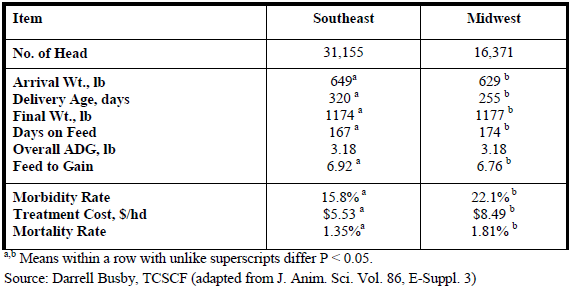



Virginia Cattle - How Do We Stack Up?
The Virginia Retained Ownership Program (ROP) offers Virginia cow-calf producers the opportunity to retain ownership on a portion of their calf crop (as few as 5 head). This scheme, and others like it across the country, allow producers to pool their calves and feed them together in order to gather objective data regarding the feedlot performance, carcass merit and health of their cattle, writes Dr Scott P. Greiner, Extension Animal Scientist, Virginia Tech. This information can be used to make herd decisions regarding genetics and management, with an objective of herd improvement and enhanced profitable regardless of how the calf crop is marketed in future years. For the last several years, Virginia ROP has collaborated with the Tri-County Steer Carcass Futurity Cooperative (TCSCF). The TCSCF consists of a group of Southwest Iowa feedyards which prescribe to standardized animal management and data collection protocols for the purpose of working with retained ownership programs in several states, including Virginia. The TCSCF is administered through a board of directors, along with Iowa State University Extension personnel.
A subject often of interest to Virginia producers is how their cattle compare to others originating from other states. The TCSCF recently summarized data through their program which compared cattle of “Southeast” origin to those of Midwest origin. Cattle included in the Southeast were from 12 states (Georgia, Virginia, Alabama, South Carolina, Mississippi, Tennessee, Florida, North Carolina, West Virginia, North Carolina, Louisiana, Kentucky), whereas the Midwestern cattle originated from herds in 7 states (Iowa, Missouri, Indiana, Illinois, Nebraska, Kansas, Minnesota). The information which follows provides a summary of the results from over 47,000 fed steers and heifers participating in the TCSCF program from 2002-09 which were fed in 18 different TCSCF feedyards.
Table 1 presents comparison of performance and health parameters for Southeast vs. Midwest calves. Calves originating from SE herds were 20 pounds heavier on arrival at the feedyard, which was associated with 65 a day difference in age between the groups. Feedyard ADG and final weight of calves was similar, and as a result of heavier initial weights SE calves were on feed slightly fewer days. Health of SE calves was superior with 6.5% less of the SE calves being treated, which resulted in lower treatment costs per head. Mortality rate was low for both groups, with 0.46% less death loss in cattle of SE origin.
Effect of Region of Origin on Feedlot Performance and Health

Presented in Table 2 is the carcass merit comparison for the two regions of origin. While carcass weights, ribeye area and yield grades were similar for the two groups, the Midwestern calves excelled in cutability with a larger proportion of Yield Grade 1 & 2 carcasses and fewer discounted Yield Grade 4 & 5. In general, marbling scores and yield grades were comparable. However, calves of SE origin had a higher qualification rate for CAB compared to Midwestern calves (18.4 vs. 16.9%).
Profit was also calculated for each calf, and determined by assigning an initial value to each calf entering the feedlot based on USDA market reports. All expenses are included in the analysis, including trucking to the feedyard and the expense of mortalities was included in the profit determination. Results revealed that SE calves generated $13.55 more profit per head, mostly as a result of their superior health.
Historical data gathered through the Virginia Retained Ownership Program and elsewhere establish the following common variable for successful retained ownership:
- Excellent health (minimal sickness and low treatment costs)
- Strong growth performance, which equates to heavy live weights and carcass weights at harvest
- Desirable carcass merit with high percentage low Choice or better
Collectively, these factors equate to low costs of gain and optimum gross returns. Risk management strategies for feed and slaughter cattle prices are also important components of successful retained ownership ventures.
Effect of Region of Origin on Carcass Merit and Profitability

The Virginia Retained Ownership Program ships steers and heifers multiple times each year (September, November, December, March). Producers can participate with as few as five head. A 45-day weaning and backgrounding period is required prior to shipment. There is a minimal consignment fee of $5, and all expenses are financed through the program (deducted from proceeds- no interim feed payments required). An advance of $300 per head is available to producers sending ten or more head. For detailed information, including consignment forms, on the Virginia Retained Ownership Program visit the Virginia Tech Beef Extension site at http://www.vtbeef.apsc.vt.edu/ or contact Joi Saville at 540-231-2257 or Scott Greiner at 540-231-9159.
February 2012



